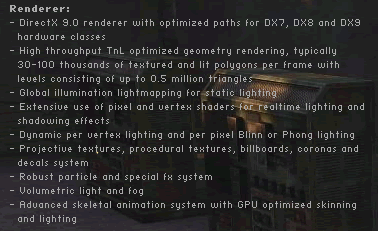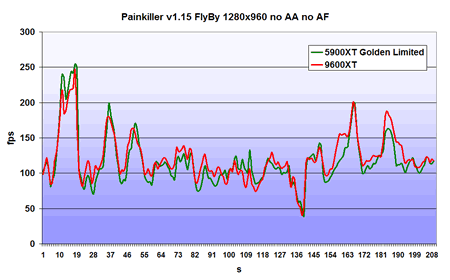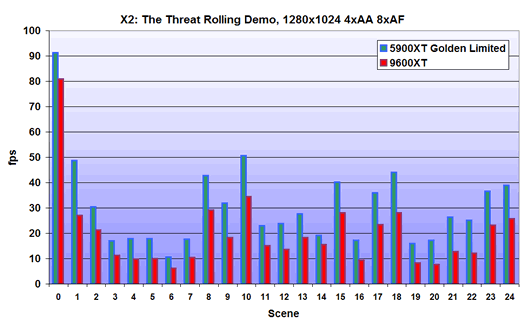Not everyone can afford a 400-500$ videocard and have to settle for the midrange cards from NVIDIA and ATI. I’ve tested Prolink’s PixelView GeForce 5900XT Golden Limited and found it an excellent midrange card with some cool extras.
Introduction![]()
Since not everyone can afford a $500 videocard there is a huge market for mid-range cards. While ATI has its Radeon 9600XT NVIDIA has had a few different options, both the GeForce FX 5700 Ultra and now the GeForce FX 5900XT. ProLink supplied me with their 5900XT card, the PixelView GeForce FX5900XT Golden Limited and today I am testing to see what 200$ are giving you.
Features and Specifications![]()
As you can figure from the name this FX5900XT isn’t your regular reference FX5900XT. But before we go into the things that make this card special, let us look at the specifications for the GeForce FX5900XT:
- 256 bit GPU
- 256 bit memory interface
- 128 MB memory, 2.8 ns
- NV35 core
- 390 MHz (Engine)/ 700 MHz (memory)
- Pixelshader 2.0 support
- 4×2 pipeline
- SVIDEO-Out, DVI, VGA
What we basically have is a lower clocked FX5950.
Let us take a look at what makes this card special:
PDFII
PDF stands for Plasma Display Fan and is a complete all-in-one thermal system complete with Aluminum Alloy housing, as well as VGA temperature and fan speed control and monitoring. The monitoring is done either through software or through the Large blue LCD display that you either can let sit on the card or put in a spare 5 1/4 slot. To lower noise the fan also switches between 3 different speeds. When the GPU is below 40 C it runs at 60% of full sped, between 40 and 60 C it runs at 80% speed and above 60C it runs at full speed.

The card with the aluminum housing.
The LCD display can be put in a frontplate that
fits into a 5 1/4″ place.
The bundle ![]()
When I unpacked the card there were 2 things that struck me. First of all the card looked cool with it’s aluminum housing as well as the little blue LCD display attached to it. The second thing was that the card was so light. Compared to other cards that usually have some copper heatsinks this card was light as a feather.
In addition to the card you get:
- transparent 5 1/4 … for the LCD
- Cable to extend the LCD display further away from the card.
- Different video cables for both SVIDEO in and composite.
- Driver CD with the software Patrolman.
- PowerDVD 3.0
The bundle is adequate without having anything special in it.
I can’t say that the bundle did impress me. All the cables are there which is a plus and the driver on the CD actually is one of the newer ones but PowerDVD 3.0? Considering that they ship WinDVD 5.0 with their Prolink PixelView PlayTV@7000 I am surprised they didn’t do the same here.
Installation![]()
My first plan was to install this card in my main machine and compare it to the scores from the PowerColor 9800SE review I did a while ago. I quickly ran into a problem though. The card didn’t fit. It wasn’t to long but it was to thick. The aluminum housing ended up right above one of the IDE connectors and there were nothing I could do to get it to fit (except cutting away some of the aluminum housing). My next step was to try it in my Shuttle SFF system. However I had a similar problem here – the aluminum housing got stuck in the drive bay above the card. In fact – I worked for over an hour to get it in and in the end I had to mutilate the housing a bit by removing the bit where the LCD was stuck on the card and then remove the whole aluminum housing, fit the card and put back the housing, to get it to fit.
I had to cut of the pieces that hold the
LCD display to get it to fit.
One funny thing is that Prolink actually has a small image of the card sitting in a Shuttle SFF system. After all my troubles I looked at the image a bit closer and guess what – the way the fitted the card is by completely removing the drive bays – no CD, no HD. What kind of system is that?
After the card was installed I tried to run some benchmarks but no games actually did work. THis is the type of graphics I got with all D3D games:
Ouch, not pretty.
While the temperatures were a bit higher than expected they still were inside the limits at around 50-60C. I was starting to suspect I had gotten a broken card. I then however decided to do some cutting in the aluminum housing to fit it into my main system. It sucks when you have to cut away pieces of the cooling system but luckily I didn’t have to do that much damage to it, just a bit in the corner.

I made sure to cut as little possible
not to disturb the airflow to much.
Since I had cut away the holder for the LCD-display I had to use the cable to hook it up. It however turned out that the cable was to short to reach the frontpanel in my lowest 5 1/4″ slot. I really think Prolink should make a 3 1/2″ frontpanel instead or make a longer cable. For the purpose of this review I ended up having it hanging out of the case.

Both the LCD display as well as the fan glows blue in your case.
Drivers and the utility of course were easy to install. While the driver on the CD both were pretty up-to-date as well as already have coolbits installed I decided to use the latest reference drivers from NVIDIA for this review.
Benchmarks![]()
The PixelView GeForce FX 5900XT Golden Limited were benchmarked against a Connect3D Radeon 9600XT. Both are similar priced midrange cards. The system that was used for the review was:
- AMD64 3000+
- AOpen AK-86-L Via K8T800
- 1024 MB PC3200 TwinMos DDR (2×512 MB)
- PixelView GeForce FX5900XT Golden Limited, Radeon 9600XT
- Soundblaster Audigy 2 ZS
- Maxtor 160 GB SATA, Maxtor 80 GB ATA133
- WinXP Pro with SP1 and all latest Security patches
- Dx9.0b
- Drivers: ForceWare 56.72 (5900XT) and Catalyst 4.4 (9600XT)
Everything was set to Quality in both drivers. As we know though NVIDIA does employ some kind of tri/bi-linear mix even when you choose to use trilinera/anistrotropic filtering. Overall NVIDIA does have slightly less image quality even though it it is close to ATI’s. Anisotropic filtering looks a bet better on NVIDIA while Antialsiasing looks better on the ATI.
Call of Duty 1.15
We’ll start off with one of the few OpenGL games that are out right now. I recorded a multiplayer demo on the map mp_brecourt and used the CoD benchmark utility to benchmark both cards at 1024×768 and 1280×960 without any Anisotropic Filtering and Antialiasing and with 4x Antialiasing and 8x Anisotropic filtering.
The 5900XT clearly has an advantage here scoring between 8 % and 35% higher than the Radeon 9600XT.
Painkiller v1.15
This game is very like Serious Sam. You just slaughter wave after wave with monsters. The game uses the Havoc engine and has high-ploygon monsters and high-res textures. Since v1.15 introduced a benchmark features I decided to try it out to see how it works. Unfortunately the fly-by benchmark does not include any monsters.
This is what “People Can Fly” says about the Havoc Engine that they use in Painkiller
Since we are not only interested in the average fps I choose to use Fraps2.1 to record the fps each second for the first 200s of the fly-by (which is about 210-215 seconds).
Without any AA or AF turned on both card did run pretty similar. There were some situations where the 5900XT drew ahead but they were pretty rare.
If we turn on 4xAA and 8xAF the GeForce 5900XT manages to nudge ahead a lot more often. Both cards play the actual game fine though.
X2- The threat Rolling demo
Last but not least I choose to run the X2: The Thread Rolling demo. While not indicative of the performance in the actual game it does however test the cards in a various of situations. Everything was set to highest quality including turning on shadows.
Without any AA and AF the 5900XT still manages to draw ahead with a healthy margin in all scenes.
If we turn on 4xAA and 8xAF the 5900XT actually draw ahead even more almost double the performance compared to the Radeon 9600XT in some scenses.
Overclocking![]()
Overclocking is handled either by the coolbit’s from NVIDIA or through the PatrolMan utility from Prolink
This is the PatrolMan utility that monitors the fans as well as allows you to overclock the card
I’m not completely sure why but everytime I did run PatrolMan it started to alarm. Asking Prolink they said that it only alarms when the fans are stopping or not working. Since the fans seemed to spin just fine I do not know what it was alerting for. The computer and card worked great so I just turned it off after applying the new settings.
One of the features of this card is the aluminium housing that allows the air to flow over the card and take the heat away. To me it sounded like it would make this card an excellent candidate for overclocking.
After some testing where I applied new settings, tested the card in Windows, Call of Duty and X2: The Threat I found that the highest I could clock the memory to was around 770 Mhz which is an 10% increase and that the core went up to 465 MHz which is almost 20% increase. I decided to stop there. This increase yielded around 15% increase in almost all benchmarks.
TV-Out![]()
More and more users want to use TV-Out to view movies and stuff that they store on their computer on their TV. The 5900XT Golden Limited has a TV-Out SVIDEO connector but no Video-In connector.
After connecting the card to the TV with a SVIDEO-cable I booted the computer. The new drivers NVIDIA has are really nice and I had no problems getting it to find the TV and set it up correctly. A few years ago getting TV-Out to work was a hit-miss situation but now I had a nice image on my TV within minutes. NView allows you to set up the TV as a separate display or to clone the main display.
The quality of the image was excellent. In fact, it was a lot better than I expected it to be. The colours were rich and while it was a bit hard to read the smaller text at 1024×768 it wasn’t impossible. NVIDIA also allows you to set up a few more resolutions like 720×576, something ATI doesn’t unless you change it in the registry.
Comparing the quality between the TV-out on my Radeon 9800XT and the TV-Out on the 5900XT it is clear that this is an area where I think NVIDIA has their nose ahead of ATI, at least with the non-ALlInWonder cards.
Everything is quiet![]()
It would be wrong not to talk about PDFII a bit more. The temperature controlled fan-speed works like a charm. Even under full stress when playing a game the temperature never rose enough to speed up the fan to full speed. Most of the time the speed held around 2900 rpm and 3800 rpm and the fan could not be heard at all. For someone building a quiet system I think this card would be perfect.
Conclusion![]()
Ignoring the initial problems with getting this card to fit in my machine I found the Prolink PixelView GeForce 5900XT Golden Limited a pleasant surprise. It won’t blow you away in terms of performance but it performs like the mid-range card it is. If I would have to suggest a mid-range card for a friend I probably would suggest one of these ahead of a Radeon 9600XT even though the 9600XT has better IQ.
I couldn’t find a US price right now for the card but at the UK site Micro Direct the card is just about 20$ more expensive than Prolink’s ‘normal’ GeForce 5900XT and similar priced as other GeForce 5900XT and Radeon 9600XT’s. The PDFII system plus the alumina housing does add value to the card, just make sure that you have the room for it.
For the excellent value I award the Prolink PixelView a Seal of Approval and the score of 8 out of 10.
Pros:
- Mid-range performance for mid-range price
- Interesting coolingsystem that actually works.
- Quiet system
- The LCD-display
Cons:
- Pretty bleak bundle. WinDVD3.0??
- PatrolMan seems to be a little flaky. Why does it alarm all the time allthough the system seems to work?
- Short cable. In a larger case the cable for the LCD display to the frontpanel is to short. And why not a 3 1/2″ frontpanel instead?
- Does not fit all systems.
- Does not work well in SFF system even though Prolink shows a pic of a card in a Shuttle-case.
 Bjorn3D.com Bjorn3d.com – Satisfying Your Daily Tech Cravings Since 1996
Bjorn3D.com Bjorn3d.com – Satisfying Your Daily Tech Cravings Since 1996



















